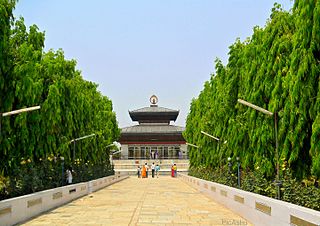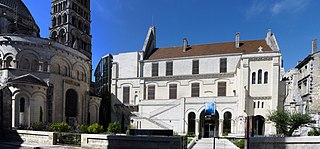
Sitamarhi is an Indian city in the Mithila region of Bihar. It is the district headquarters of the Sitamarhi district and is a part of Tirhut Division. The name of the city had kept as honours to the birthplace of the goddess, Sita. The Bihar government declared Sitamarhi a municipal council.

Darbhanga is the fifth largest city and municipal corporation in the state of Bihar in India, and is considered an important city in North Bihar. It serves as the headquarters of the Darbhanga district and the Darbhanga division. It is held that the name Darbhanga has been derived from Dwar Banga or Dari – Banga, meaning the 'door of Bengal'.

Madhubani is a City Municipal Corporation and headquarter of Madhubani district. Madhubani is situated in the Indian state of Bihar. It comes under Darbhanga Division. It is situated at 26 km northeast of Darbhanga City. The Madhuban Raj in Madhubani was created as a consequence. The word "Madhuban" means "forest of honey", from which Madhubani is derived, but sometimes it is also known as "madhu"+"vaani" meaning "sweet" "voice/language".

Madhubani art is a style of painting practiced in the Mithila region of India and Nepal. It is named after the Madhubani district of Bihar, India, which is where it originated. Artists create these paintings using a variety of mediums, including their own fingers, or twigs, brushes, nib-pens, and matchsticks. The paint is created using natural dyes and pigments. The paintings are characterised by their eye-catching geometrical patterns. There is ritual content for particular occasions, such as birth or marriage, and festivals, such as Holi, Surya Shasti, Kali Puja, Upanayana, and Durga Puja.

Sitamarhi is one of the districts in the Mithila region of the Indian state of Bihar, India. Dumra is the administrative headquarters of this district. The district is a part of the Tirhut Division and is located along the border of Nepal.

The National Museum in New Delhi, also known as the National Museum of India, is one of the largest museums in India. Established in 1949, it holds a variety of articles ranging from pre-historic era to modern works of art. It functions under the Ministry of Culture, Government of India. The museum is situated on Janpath. The blue–print of the National Museum had been prepared by the Gwyer Committee set up by the Government of India in 1946. The museum has around 200,000 works of art, mostly Indian, but some of foreign origin, covering over 5,000 years.
Maithils, also known as Maithili people, are an Indo-Aryan ethno-linguistic group from the Indian subcontinent, who speak the Maithili language as their native language. They inhabit the Mithila region, which comprises Northern and Eastern Bihar and Northeastern Jharkhand in India and some adjoining districts of Nepal constituting Madhesh Province in addition to some terai districts of Bagmati and Koshi Provinces. The Maithil region forms an important part of Hinduism as it is said to be the birthplace of Sita, the wife of Ram and incarnation of Lakshmi.

The Amar Mahal Palace is a palace in Jammu, in the Indian erstwhile Kingdom of Jammu and Kashmir, India. The palace has now been converted into a museum. Commissioned by Maharaja Amar Singh, a Dogra king, the palace was built in the nineteenth century by a French architect on the lines of a French Chateau. The palace was donated to the Hari-Tara Charitable Trust by Karan Singh for use as a museum. It has many exhibits including a golden throne weighing 120kg, a Pahari miniature, Kangra miniature paintings, a library of 25,000 antique books, many rare art collections, and a large collection of portraits of the royal family.
The Darbhanga Raj, also known as Raj Darbhanga and the Khandwala dynasty, was a Maithil Brahmin dynasty and the rulers of territories, not all contiguous, that were part of the Mithila region, now divided between India and Nepal.

Mithila, also known as Tirhut, Tirabhukti and Mithilanchal is a geographical and cultural region of the Indian subcontinent bounded by the Mahananda River in the east, the Ganges in the south, the Gandaki River in the west and by the foothills of the Himalayas in the north. It comprises certain parts of Bihar and Jharkhand of India and adjoining districts of the Koshi Province, Bagmati Pradesh and Madhesh Province of Nepal. The native language in Mithila is Maithili, and its speakers are referred to as Maithils.

The National Handicrafts and Handlooms Museum (NHHM) commonly known as National Crafts Museum in New Delhi is one of the largest crafts museums in India. It is run by the Ministry of Textiles, Government of India. The museum is situated on the corner of the Pragati Maidan, facing the Purana Quila complex. In 2015, the Government of India announced that a Hastkala (handicrafts) Academy would be established in the museum premises, converting some galleries into classrooms. Initial renovations destroyed one of the museum's most well-known artifacts, a room of murals painted by Madhubani artist Ganga Devi, leading to widespread criticism. As of 2019, renovations are still ongoing.

The Albert Hall Museum in Jaipur is the oldest museum of the state and functions as the state museum of Rajasthan, India. The building is situated in Ram Niwas garden outside the city wall opposite New gate and is a fine example of Indo-Saracenic architecture. It is also called the Government Central Museum. It was considered one of the best 19th century museums for the variety of its collections. It was renovated in 2008 and reopened as one of the most advanced museums in India.

Watson High School Madhubani is a high school located in Madhubani, Bihar, India. It was established in 1901 by A. W. Watson, who was Sub-Divisional Officer in Madhubani from November 1900 to April 1903.

The Musée d'Angoulême, formerly the Musée des beaux-arts d'Angoulême, is a public museum in Angoulême, France. Located beside the Angoulême Cathedral in the heart of the historical center of the city, it is classified as a Musée de France, and has important archaeological, ethnographic and artistic collections. It also hosts temporary exhibitions and conferences.
Bharti Dayal is an Indian artist who specializes in Madhubani art.

Manas Bihari Verma was an Indian aeronautical scientist instrumental in the development of the light combat aircraft, Tejas. In 2018, he was conferred the Padma Sri civilian honour by the President of India. After his retirement he launched Mobile Science Lab aimed at promoting science education in Bihar.
Godawari Dutta is an Indian painter, well known for Madhubani Painting and patron of Mithila Kala Vikas Samiti. She was awarded India's fourth highest civilian award the Padma Shri.
The Maharajadhiraj Lakshmishwar Singh Museum is situated at Darbhanga in the Indian state of Bihar. It has the largest collection of ivory craft items in India.
The Lord Vishnu Statue in Biarwa is an ancient statue of Lord Vishnu.
Sita Devi (1914–2005) was an Indian artist, specializing in painting in the Madhubani tradition. She is one of the most well-known Madhubani artists from India, and was one of the first to receive national recognition for the art form, receiving a number of awards for her work including the Padma Shri in 1981, as well as the Bihar Ratna Samman in 1984. She was influential in activism for local development in her village of Jitwarpur, in the state of Bihar, and taught Madhubani art to local residents, especially women, during her career in an effort to encourage financial stability. Her paintings have been praised for their individual style, particularly their use of color, have been widely exhibited, and are archived in India as well as in museums in France, the United States, the United Kingdom, and Japan.


















